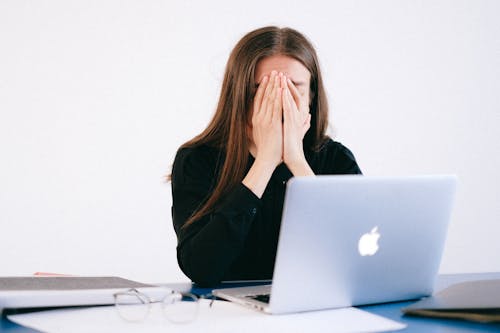
Understanding the difference between stress and anxiety is crucial for managing your mental health. Many people confuse anxiety for stress and vice versa.
What exactly is the difference between stress and anxiety? Imagine two typical people, both on their way to work on a weekday morning.
Both of these people have a sore neck, a slightly upset stomach, and are fidgeting in their seats. Neither got much sleep last night.
One of them was up late worrying about a big project that’s due by the end of the week. Before bed, she was going over her family’s finances and was wondering how they were going to cover the cost of her oldest son’s tuition this year. She’s still wondering if she should get a part-time job. As if that wasn’t enough, last week she had an argument with a good friend that still hasn’t been resolved.
Now, the second person was up late wondering if his girlfriend was thinking about leaving him. All afternoon the previous day, he was too distracted worrying about the current state of the economy and the climate crisis to get any work done, and his boss reprimanded him. Now on the bus, he can’t stop thinking that everyone else on his commute is looking at and judging him.
Both of these people are experiencing emotional responses to something. The difference is that one of them is living with anxiety and the other is feeling stress.
Can you tell them apart?

What Exactly is Anxiety?
Anxiety is an emotion characterized by fear, tension and/or worrying. Often, there are seemingly no triggers for anxiety; most anxiety stems from a person’s own thoughts and perceptions.
According to mental health statistics obtained by SingleCare in 2018, anxiety and anxiety disorders were the most common form of mental illness worldwide, affecting more than 200 million people around the globe.
Stress, on the other hand, is an emotional response triggered by an external stimulus, such as getting fired, a breakup, financial distress or losing something valuable. Stress can be long or short-term and is much more manageable than anxiety.
Stress, unlike anxiety, cannot be diagnosed as a disorder. Stress is a symptom of anxiety, and anxiety disorders can be diagnosed.
Common Anxiety Disorders Include:
- General anxiety disorder: Excessive, uncontrollable worry about varied events (both minor and major) in your daily life.
- Social anxiety: Excessive fear of being watched, judged and criticized by others, even strangers.
- Phobias: A strong and unsubstantiated fear of something, such as agoraphobia (fear of leaving an environment the person perceives as safe, usually their own home) arachnophobia (fear of spiders) or autophobia (fear of being alone), to name a few.
Is it an Anxiety Disorder or Stress?
How can you tell whether you have an anxiety disorder or are just going through a stressful time in your life?
It can be challenging to differentiate because the difference between stress and anxiety is not always obvious. For mild cases, both stress and anxiety can look strikingly similar. Physical symptoms of both stress and anxiety can include insomnia, irritability, muscle tension, headaches, restlessness, an increased heart rate and trouble concentrating.
When you’re stressed, that’s a response to a stressor and there are steps you can take on your own to manage it. Even though stress can be long-term, (and long-term stress can lead to mental health problems, including anxiety) stress can usually be managed on your own or with very little help.
Anxiety, on the other hand, can be more chronic and can significantly disrupt your life in a number of ways.
For starters, people who suffer from an anxiety disorder worry about many, many different things, sometimes simultaneously. Alternatively, the person might bounce from topic to topic, worrying all the while. Anxiety can be overwhelming and significantly disrupt a person’s life, ruining their appetite, disrupting a healthy sleep schedule and interfering with their professional endeavours. To an outsider, their fears and worries appear to be baseless, but they are very real to someone with chronic anxiety. Anxieties can stem from childhood trauma, warped perceptions of the world around them, physical trauma or a chemical imbalance in the brain.
Anxiety disorders can also come with a host of other physical symptoms including those typical of panic attacks; excessive sweating, a very rapid heart rate, hyperventilating and dizziness. Panic attacks can be isolated incidents that happen to anyone, but someone living with an anxiety disorder might experience them up to several times a week, in the worst cases.
Generally, if someone spends a large part of the majority of their days in a heightened state of anxiousness for longer than six months, that is a good indicator that they may have an anxiety disorder.
The Neurology Behind Stress and Anxiety
In a healthy brain, activity between the emotional response centre of the brain and the area responsible for higher cognitive function is well-balanced.
For individuals with higher levels of anxiety, there is much more activity happening in the emotional structures, otherwise known as the limbic system, than in the cognitive structures, which are responsible for things like planning, understanding, moderating behaviour and controlling impulses.
The amygdala is the structure within your limbic system that controls your mood and emotions. During a panic attack, it essentially ‘takes over’ your rational brain, rendering you unable to assess the situation objectively and calm yourself.
A similar reaction is observed when you experience high levels of stress. If you are chronically stressed, your prefrontal cortex actually shrinks, and your amygdala grows, which in turn makes you more susceptible to stress.
Without treatment, this cycle of stress and response can continue on and on and have detrimental effects on your cognitive and social abilities, as well as your mental and physical health.
Anxiety in Children
Many children have fears, but when a child’s anxiety is causing them to miss out on regular childhood experiences, avoid making friends and refuse to try new things, it’s worth mentioning to their doctor. Children can be susceptible to developing anxiety disorders, too, and some symptoms can present in the same way they do in adults. Additionally, a child with an anxiety disorder may also display selective mutism, extreme separation anxiety, bedwetting and nightmares.
It’s important to confront the problem instead of waiting for them to ‘grow out of it’. If left untreated, anxiety can derail neurodevelopment, child development and even a mild case can grow into something unmanageable as the child gets older.
Changes to routine, a move to a new neighbourhood or city, starting school or going to summer camp can trigger anxiety in someone who’s genetically predisposed to it.
Fortunately, there are a number of treatment options available for children with anxiety.
A child therapist can work with an anxious child to develop healthy, impactful ways of dealing with the big feelings associated with childhood anxiety. Known as cognitive behavioural therapy (CBT), this type of treatment has proven tremendously effective for a number of disorders, including anxiety. It is especially successful when used with children, as a younger brain is more able to change through a process known as neuroplasticity.

Overcoming Stress and Anxiety
Physical activity, a healthy diet and practising good sleep hygiene are all ways you can keep your brain healthy and able to respond effectively to highly stressful situations, but when stress takes over, the first and the best thing you can do is remove the stressor. If permanent removal isn’t an option, simply taking some time away and coming back in a less heightened state can make a world of difference; talk a walk, try a calming activity like colouring or drawing, or spend some time in nature.
If anxiety has taken over your life, consider consulting with a therapist or psychiatrist. When combined, talk therapy, cognitive behavioural therapy and drug therapy are proven, effective means of treating chronic anxieties. Exposure therapy may be suggested if anxiety is stemming from a phobia.
Finally, mindfulness meditation has had remarkable results for people living with many mental health conditions including anxiety, depression, ADHD, addiction and even physical symptoms such as IBS or chronic pain.
Personal experiences and environmental factors can contribute greatly to someone’s stress and anxiety, but studies also show that your genes can make you more susceptible to these conditions.
A CircleDNA test can provide you with stress and sleep reports, and confirm whether or not you are genetically predisposed to anxiety.







Comments are closed.